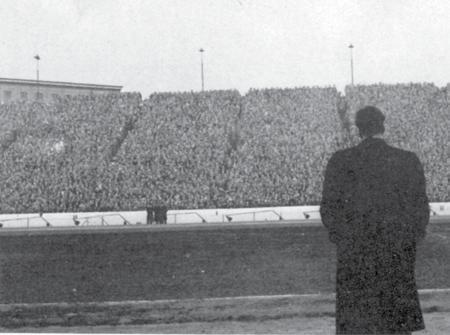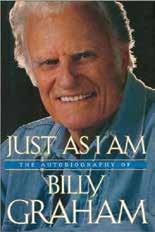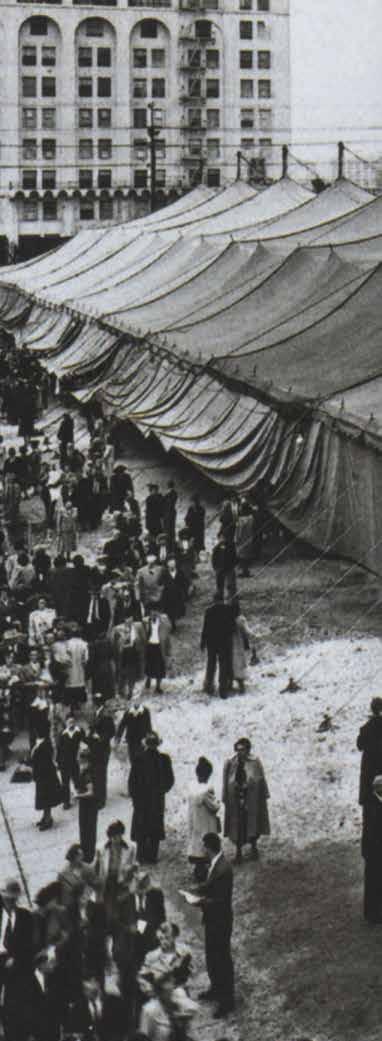
12 minute read
Just As I Am: The Autobiography of Billy Graham
by Billy Graham
REVIEW BY DR. MICHAEL J. PLATO Assistant Professor of Intellectual History and Christian Thought

Since Billy Graham went to meet his Lord and Savior on February 21, 2018, there has been an increasing interest in assessing Graham’s life and achievements. A number of substantial biographies had already been written, and they are now being joined by more recent and still impending works. Even Graham’s late wife, Ruth, is getting a new in-depth and scholarly biography next year. While many commentators within and outside the church will be offering interpretations of the legacy of this man who preached directly to more individuals than any other Christian in history, Graham’s own understanding of his life and work should not be obscured or forgotten. As such, and in conjunction with Colorado Christian University’s new exhibit on the life and ministry of Billy Graham this spring, it is perhaps timely to reconsider Graham’s own major reflection on his life: his autobiography from 1997, Just As I Am.
BILLY GRAHAM’S LIFE
Before examining the book itself, and evaluating its strengths and weaknesses, it will be helpful to briefly outline the major events of his life. William Franklin “Billy” Graham was born
in Charlotte, North Carolina, on November 7, 1918. The first of four children, he was raised on a dairy farm. Though he was born into a Christian home, young Billy showed no more than a nominal interest in the faith of his parents. He aspired to become a professional baseball player. Just before his 16th birthday that all changed. Attending a revival meeting conducted by the traveling evangelist, Mordecai Ham (1877‒1961), Billy made the decision to follow Christ. Over the next few years God’s plan for his life would be gradually made apparent.
On his mother’s advice, he first briefly attended Bob Jones College (later Bob Jones University), before making the switch to Florida Bible Institute. Graham still had doubts as to what he was going to do with his life, but while on a Florida golf course it was made clear that he was to spend his life in service to God.
After graduating in 1940, Graham went to Wheaton College in Illinois to continue his studies for the ministry. Wheaton and the move to the Chicago area would prove formative to his later development. Perhaps the most significant thing that happened to him was meeting the woman who would eventually become his wife, the daughter of missionaries to China, Ruth McCue Bell (1920‒2007).
Immediately following Wheaton, Graham married Ruth and began a career in pastoral ministry in Illinois. This career as a church minister would last only a little over a year. He had begun to recognize that his true gifts were for evangelism.
In 1944 Graham began working for a new organization called Youth for Christ (founded in Chicago and now headquartered in Englewood, Colorado). As World War II was coming to a close, Graham sought to evangelize returning soldiers. Through Youth for Christ he preached to them across the nation. After the war had ended, Graham’s ministry would take him overseas for the first time.
By 1948 Graham had parted company with Youth for Christ and briefly ran Northwestern Schools in Minneapolis, Minnesota (now the University of Northwestern, St. Paul). He also began to lead revivals in North Carolina, where he had settled in Montreat with Ruth.
In 1949 Graham was invited to conduct a large tent revival in Los Angeles. This would prove to be a major turning point in his career.
Initially the revival was poorly attended. Then suddenly he gained considerable attention. The media mogul, William Randolph Hearst (1863‒1951), for reasons of his own had decided to “puff Graham” in his papers. Soon Billy Graham was gaining national and international attention. Things would never be the same.
Over the next several decades, Graham’s evangelism would move onto an increasingly larger world stage. In 1950, he began the Billy Graham Evangelistic Association to help him administer his revival crusades and media ministry. Over the course of nearly six decades Graham conducted 417 crusades; preached in 185 countries to 215 million people. He would also publish 33 books, start the magazines Christianity Today and Decision Magazine, as well as produce numerous radio and television programs. He would become a counselor to American presidents and evangelical Christianity’s most recognizable international ambassador. Despite his global travel and worldwide friendships, Graham always considered North Carolina his home and it was there that he passed away at the age of 99.
THE AUTOBIOGRAPHY
Just As I Am was published in 1997, 21 years before Graham’s death. As such, it does not cover some of the most significant events of Graham’s later life, including his speaking at the 9/11 memorial service or his final crusade of 2005. Yet it does comprehensively cover his life until the age of 79.
Graham’s autobiography is at once intimidating and approachable. At almost 800 pages, its sheer bulk may be overwhelming to some, but in the reading it is quite accessible. As with his preaching there is a common touch which many can relate to — at times it verges on the folksy. He even refers to his parents as his “folks.” His father is sometimes “dad” or “Daddy”; mother, however, is always “Mother.”
Structurally, the narrative is arranged chronologically and he hits all the main points outlined in the summary of his life above, though in much greater detail. At times there is a lightness of touch, even a charm and sense of humor. For example, here is how he introduces his chapter on courting Ruth:
“Saturday nights I dedicate to prayer and study, in preparation for the Lord’s day.”
What kind of romance could a college man have with a woman who said a thing like that? Dating Ruth Bell had to be creative. And I did my best. For example, on one occasion we took a long walk to the graveyard, where we read tombstone epitaphs!1
Along with happy moments are some of the sadder ones as well. One of the best-known incidents from early in his ministry was when his friend and evangelistic colleague, Charles Templeton, began to study liberal biblical scholarship and came to doubt his faith. Templeton’s questioning, which eventually lead to Templeton abandoning the Christian faith altogether, affected Graham for a period and led to Graham’s own dark night of the soul. Graham would come out on the other side with his faith intact, but it is worth hearing the episode in his own words to get a sense of the personal despair that gripped him for a time:
I never doubted the Gospel itself… but other major issues were called into question. The particular problem I was wresting with… was the inspiration and authority of the Scriptures…
Could the Bible be trusted completely?
– Billy Graham

I had similar questions arising from my own broadened reading habits. I wanted to keep abreast of theological thinking at mid-century… I never doubted the Gospel itself… but other major issues were called into question. The particular problem I was wresting with… was the inspiration and authority of the Scriptures… Could the Bible be trusted completely?... The disturbing conversations with Chuck Templeton, my confused reaction to studying influential and sometimes contradictory theologians… all these were the intellectual, spiritual and emotional baggage I was carrying in the summer of 1949 as we began to prepare for Los Angeles.2
Despite these and numerous other places where Graham discusses his personal life and theological struggles, there is often a sense that they are background to his encounters with the great and famous of the world.
One immediately gets a sense of this in his introduction where he declares that his meetings with President Harry S. Truman in 1950 and President Kim Il Sung of North Korea in 1992 were like “bookends” on his “shelf of memories.” Everything and everyone else seems to fit in between them. Even many of the chapters are dedicated to encounters with individual men, most especially American presidents. For those looking to learn more about Graham himself, this can seem distracting, and inflating to an already oversized book.
To be fair, as a global figure himself, Graham probably recognized that many of his readers would be wanting to hear his thoughts on meeting and knowing prominent and powerful people. The index is largely dominated by names, rather than subjects. Yet as a confidant and spiritual counselor, this also puts him into something of a quandary. He does share a lot, but quite often there will also be a clear point where he will go no further.
His writing on Queen Elizabeth II can perhaps serve as something of an example of this. Since Graham’s fictional portrayal in the Netflix series, “The Crown,” many viewers have been curious to know what exactly transpired between the preacher from Charlotte and the Queen. What can one find here if one is looking for details? The answer is, not much:
No one in Britain has been more cordial towards us than Her Majesty Queen Elizabeth II. Almost every occasion I have been with her has been in a warm, informal setting, such as a luncheon or dinner, either alone or a few family members or other close friends. Out of respect for her privacy and that of her family, I will say little more.3
Graham chooses not only to be tight-lipped with regard to many of his most influential conversations, but he leans in an interpretive direction that is almost always charitable. In his chapter on President Richard Nixon, which was written years after the initial exposure of Watergate, Graham still highlights what he thinks were Nixon’s better motives. Just As I Am was written before the revelation of tapes of conversations between Nixon and Graham. These recordings were not flattering for Graham. Segments of the tapes exposed the president’s cynical attempts to manipulate Graham and exploit his public image. One wonders how different this chapter would read had it been written a few years later.
There are other areas where people have found reasons to be critical of the autobiography. Graham often appears to gloss over matters concerning his broad ecumenism, an aspect of his ministry that distressed many evangelicals. He also focuses on the more positive aspects of his handling the volatile social and political issue of race relations, and ignores his failings in this regard. That Graham does not spend much time justifying himself or being openly self-critical may not satisfy those who find these aspects problematic, but he does acknowledge many of his faults when he sees them. There will no doubt be other biographies that delve into his failings in much greater detail, and there already are. The value in reading an autobiography, however, is that the subject is given a place to provide his or her own perspective and explanation for why they did what they did.

Graham chooses not only to be tight-lipped with regard to many of his most influential conversations, but he leans in an interpretive direction that is almost always charitable.
Christ raises up people for their specific times and places...

One thing that is abundantly clear when reading through Just As I Am is the titanic cultural, social, and political shift that has taken place in America and the world from the time of Graham’s Cold War-dominated late 20th century to our own more “woke” but uncertain times. Graham was addressing a largely biblically literate culture (at least in America) and his message often focused on the despair and malaise that many were feeling following World War II.
We now live in an age that is in many ways less naïve, but it is also an age when the Christian ethos is no longer assumed by many, and Christianity as a whole is under greater siege.
That Graham may seem out of place in terms of many of our sensibilities should in some ways be expected. This is not meant as an excuse for his failings, but it should nevertheless nuance our perspective and framing of the man.
Since Graham’s passing, some commentators have wondered at the possibility of another Graham-like figure emerging on the scene. In this reviewer’s opinion, especially after having spent the past several months intensively studying him and his ministry, this seems to be highly unlikely, at least in the foreseeable future. The same conditions are just not there. But also we might wonder if this is something we should even desire. Christ raises up people for their specific
times and places, whether it is an Athanasius, an Augustine, a Luther, a Jonathan Edwards, a Sophie Schol, or a Billy Graham. And so we must expect that those who will stand for Christ and his unchanging gospel in our own time or in the near future, will in some way be fitting and responsive to their age’s unique and pressing challenges. In this sense, when we read Graham’s autobiography, whatever his faults and weaknesses or strengths and successes, we should be mindful that we are not simply encountering a remarkable, fascinating, flawed, or dull individual. We should not read Graham’s life seeking to find a plan for our own lives. Nor should we be reading it to find a fitting version of the celebrity-worship on which our culture seems to be so fixated. Rather, we should be mindful that we are peering in on one figure on one small stage of the ever-unfolding panoply that is the Spirit-directed mission of the church.
FOOTNOTES
1 Billy Graham, Just As I Am: The Autobiography of Billy Graham (HarperCollins, 1997) 71.
2 Graham, Just As I Am, 135-136.
3 Ibid, 689.
REVIEWER BIO

MICHAEL J. PLATO
Michael J. Plato is Assistant Professor of Intellectual History and Christian Thought at Colorado Christian University. He is also lead curator and historian for CCU’s Billy Graham exhibit in 2020.








